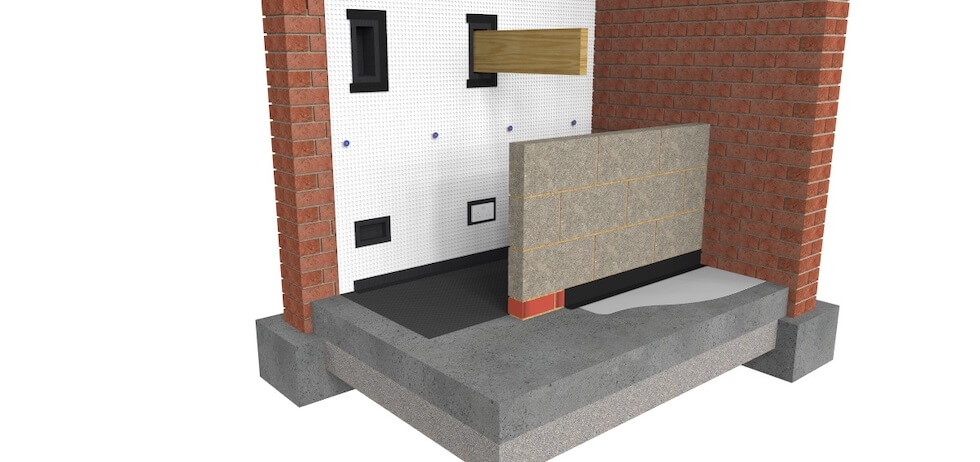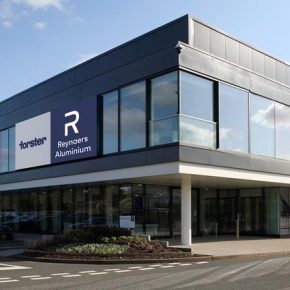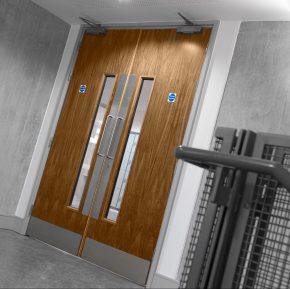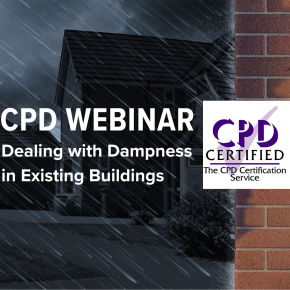
Newton: Waterproofing and Damp Proofing – Which Service Do You Need?
Architects, specifiers, and contractors frequently encounter projects where moisture management is a critical consideration. Selecting the right course of action can be crucial, and understanding the source of the issue, as well as the distinctions between damp proofing and waterproofing is essential for achieving a successful and lasting solution. Newton Waterproofing‘s managing director Warren Muschialli writes the following piece…
“Damp proofing and waterproofing, while often used interchangeably, address distinct challenges in building construction.
Damp Proofing vs. Waterproofing: Defining the Differences
Damp Proofing
This method focuses on controlling moisture movement within porous building materials above ground level. Frequently it is used to combat rising and penetrating damp caused by factors such as wind-driven rain, condensation, or lateral moisture ingress from adjacent ground. Damp proofing solutions aim to create a moisture barrier within the building fabric, preventing it from reaching and damaging internal walls and finishes.

Common damp proofing techniques include:
– Damp proof courses (DPCs): A horizontal barrier, typically a plastic sheet or bituminous material, installed within the wall construction to prevent rising damp from ground moisture.
– Structural damp proof membranes (DPMs): Typically a thin, sheet membrane that protects a structure from moisture from the ground rising through the concrete slab via capillary action.
– Internal damp proofing membranes: An impervious membrane with a studded profile that is fixed to internal walls to create an air gap. This allows for vapour equalisation whilst isolating the damp structure from the internal wall finish.
– Surface Treatments: Used both internally and externally to create structural walls that are drier, warmer, and more thermally efficient.
Selecting the appropriate damp proofing method depends on the specific cause and location of the damp issue. It’s therefore crucial to correctly identify the source of the problem through a damp survey conducted by a qualified surveyor.
Waterproofing
This approach creates a robust and comprehensive strategy specifically designed to prevent water ingress into below-ground and partially retaining structures. It’s essential in basements, car parks, and other areas where groundwater can pose a risk at any point in the lifetime of the building. The primary goal of waterproofing is to achieve the desired internal environment, as specified by the project requirements, and therefore achieving the intended use of the space.
Waterproofing systems typically involve a combination of products and techniques, including:
– Barrier membranes (Type A Waterproofing): Sheet membranes, such as the Newton HydroCoat System and HydroBond System, applied either internally or externally to the structure to provide a watertight barrier against water ingress.
– Structurally integral systems (Type B Waterproofing): Systems like the Newton HydroTank System ensure watertightness by integrating waterproofing materials directly within the concrete structure itself, creating a robust and reinforced barrier against water ingress.
– Drained cavity systems (Type C Waterproofing): Solutions such as the Newton CDM System utilise a combination of internal products to create a cavity drain system that collects and manages any water ingress, allowing for its safe removal and preventing damage to internal fixtures and finishes.
Identifying the Right Solution: When to Choose Damp Proofing and When to Opt for Waterproofing
The decision of whether to employ damp proofing or waterproofing hinges on several factors, including:
– Location of the issue: Damp proofing is generally suitable for above-ground structures experiencing rising or penetrating damp. Waterproofing, on the other hand, is essential for below-ground structures where there is a risk of water ingress due to groundwater or other unpredictable events such as flooding or burst water mains.
– Severity of the problem: For minor issues, damp proofing may be sufficient to alleviate the problem. However, for more severe and persistent damp problems, particularly those involving water ingress under pressure, one or more waterproofing systems are the only viable solution.
– Intended use of the space: The intended use of the space also influences the choice between damp proofing and waterproofing. For habitable spaces below ground, such as basements or converted cellars, waterproofing is necessary to create a dry and healthy environment. In comparison, damp proofing might be adequate for non-habitable spaces such as storage areas, provided the damp issue is not severe and moisture levels are controlled appropriately for the intended use of the space.
Why Specialist Waterproofing Contractors Are Essential
Damp proofing and waterproofing projects, particularly for below-ground structures, require a high level of expertise and experience. Selecting a reputable and qualified contractor specialising in these areas offers several crucial advantages:
– Guaranteed workmanship: Newton’s network of Specialist Basement Contractors (NSBCs) are vetted for quality workmanship and adhere to strict criteria. This ensures projects are completed to the highest standards and come with meaningful, insured installation guarantees.
– Design and installation expertise: Our NSBCs can handle both the design and installation of waterproofing systems, providing a complete and streamlined solution. This eliminates potential communication gaps and ensures all aspects of the project are coordinated effectively.
– Design liability insurance: Many NSBCs hold design liability insurance. This allows you to delegate design responsibility for the waterproofing aspect of the project, fulfilling the role of ‘waterproofing specialist’ as recommended by British Standard BS 8102:2022 for waterproofing below-ground structures.
The Importance of Combined Systems in Waterproofing
The British Standard BS 8102:2022, the ‘Code of Practice for Protection of Below Ground Structures Against Water Ingress’, emphasises the value of utilising a combination of waterproofing methods for optimal protection.
– Type A (Barrier) Protection. Barrier membranes such as those offered by Newton provide a physical barrier against water ingress, acting as the first line of defence.
– Type B (Structurally Integral) Protection. Systems like Newton HydroTank integrate waterproofing materials within the concrete structure itself, creating a robust and monolithic barrier against water pressure.
– Type C (Drained) Protection. Drained systems like Newton CDM collect and manage any water ingress that may bypass the primary barrier, providing an additional layer of protection and ensuring the structure remains dry.
By combining these different types of waterproofing methods, a more comprehensive and robust defence against water ingress is achieved, promoting long-term structural integrity and occupant well-being.
Choosing the Right Partner for Damp Proofing and Waterproofing Needs
Damp proofing and waterproofing projects demand a thorough understanding of the specific challenges at hand. Selecting the right course of action is crucial for achieving a successful and lasting solution. Here at Newton Waterproofing, we are committed to providing architects, specifiers, and contractors with the knowledge and resources they need to make informed decisions.
– Free technical support: Our team of experienced professionals is available to offer free technical support and advice on all aspects of damp proofing and waterproofing.
– Nationwide network of specialist contractors: Our network of NSBCs guarantees access to qualified and experienced contractors throughout the UK for professional installation.
– Site surveys and specifications: Where required, our specialist contractors can conduct comprehensive site surveys to assess the specific needs of your project and develop a tailored waterproofing or damp proofing specification.
– High-quality products and systems: Newton offers a comprehensive range of high-quality waterproofing and damp proofing products and systems, ensuring we have the right solution for your project requirements.
By understanding the distinctions between damp proofing and waterproofing, and by partnering with a reputable specialist contractor, you can ensure your project is protected from the damaging effects of moisture, safeguarding the building’s structural integrity and promoting a healthy environment for occupants.
For more information on how Newton Waterproofing can assist you with your damp proofing or waterproofing needs, please contact us today.”
Newton Waterproofing Systems,
Newton House,
17-20 Sovereign Way,
Tonbridge,
Kent,
United Kingdom,
TN9 1RH
Phone: 01732 360 095
Fax: 01732 359 033
E-mail: [email protected]
Visit Newton Waterproofing System's website
Visit Supplier's page
Latest news

27th June 2024
Govette Windows wins Best Domestic Project at the SWA Awards 2024
Govette Windows has won the Best Domestic Project category at the Steel Window Association Awards for work on a house extension in Weybridge, Surrey.
Posted in Articles, Awards, Building Industry Events, Building Industry News, Building Products & Structures, Building Systems, Case Studies, Doors, Glass, Glazing, Restoration & Refurbishment, Retrofit & Renovation, Steel and Structural Frames, Windows
27th June 2024
Reynaers is officially ‘A’ good place to work
Reynaers Aluminium has been rated ‘A’ good place to work following a staff survey. The report, part of the company’s ‘Together for Better’ strategy to support employee satisfaction, saw the UK company gain its highest levels of validation for workplace practices – securing an overall ‘A’ rating from staff.
Posted in Aluminium Products, Articles, Building Industry News, Building Products & Structures, Building Regulations & Accreditations, Building Systems, Cladding, Curtain Walling, Doors, Facades, Health & Safety, Publications, Recruitment, Research & Materials Testing, Restoration & Refurbishment, Retrofit & Renovation, Walls, Windows
26th June 2024
ASSA ABLOY Door Group highlights fire door safety issues in educational environments
Door Group, a unit of ASSA ABLOY Opening Solutions UK & Ireland, is highlighting the lack of fire safety in education environments.
Posted in Access Control & Door Entry Systems, Architectural Ironmongery, Articles, Building Industry News, Building Products & Structures, Building Regulations & Accreditations, Building Services, Doors, Facility Management & Building Services, Health & Safety, Restoration & Refurbishment, Retrofit & Renovation, Security and Fire Protection
25th June 2024
Safeguard’s most popular webinar - now approved by The CPD Certification Service
Safeguard Europe is now a member of The CPD Certification Service: the world’s leading organisation for Continuing Professional Development training events, courses, workshops and webinars.
Posted in Articles, Building Associations & Institutes, Building Industry Events, Building Industry News, Building Products & Structures, Building Regulations & Accreditations, Building Services, Continuing Professional Development (CPD's), Damp & Waterproofing, Facility Management & Building Services, Information Technology, Plumbing, Restoration & Refurbishment, Retrofit & Renovation, Seminars, Training
 Sign up:
Sign up: